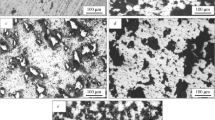Abstract
Cu + Cr3C2 composites have been produced using the mechanical alloying of the elemental components, followed by severe plastic deformation by torsion, magnetic-pulse pressing, and electric-pulse plasma sintering. The composites are studied using X-ray diffraction and light and electron microscopy, as well as measurements of the hardness, density, and electric conductivity. Magnetic-pulse pressing at a temperature of 500°C makes it possible to produce volume nanocomposites with a homogeneous distribution of dispersed carbides over the copper matrix, which has a density of 96%, a Vickers microhardness of 4.6 GPa, a Rockwell hardness of 69 HRA, and an electric conductivity of 19% IACS units. Using electric-pulse plasma sintering at a temperature of 700°C, composites with the nanostructured copper matrix, which contains carbide inclusions and consists of domains surrounded by a layer of nearly pure copper, have been produced. These composites have a density of 88%, a Vickers microhardness of 4.0 GPa, a Rockwell hardness of 58 HRA, and electric conductivity of 26% IACS units.
Similar content being viewed by others
References
C. Suryanarayana and Al-Aqeeli Nasser, “Mechanically alloyed nanocomposites,” Prog. Mater. Sci. 58, 383–502 (2013).
G. S. Upadhyaya, Powder Metallurgy Technology (Cambridge Int. Sci., Cambridge, 2002).
B. D. Long, M. Umemoto, Y. Todaka, R. Othman, and H. Zuhailawati, “Fabrication of high strength Cu–NbC composite conductor by high pressure torsion,” Mater. Sci. Eng., A 528, 1750–1756 (2011).
G. H. Lee, Ch. K. Rhee, M. K. Lee, Wh. Wh. Kim, and V. V. Ivanov, “Nanostructures and mechanical properties of copper compacts prepared by magnetic pulsed compaction method,” Mater. Sci. Eng., A 375–377, 604–608 (2004).
Zh.-H. Zhang, F.-Ch. Wang, L. Wang, and Sh.-K. Li, “Ultrafine–grained copper prepared by spark plasma sintering process,” Mater. Sci. Eng., A 476, 201–205 (2008).
M. A. Eremina, S. F. Lomaeva, E. P. Elsukov, L. E. Bodrova, E. Yu. Goida, and E. A. Pastukhov, “Copper–chromium carbide composites produced by mechanical activation of initial components in the solid and liquid states,” Khim. Fiz. Mezosk 15, 262–269 (2013).
M. A. Eremina, S. F. Lomaeva, and E. P. Elsukov, “Formation of chromium carbides in copper matrix during mechanical alloying in carbon-containing media,” Phys. Met. Metallogr. 114, 928–934 (2013).
M. Lopez, C. Camurri, V. Vergara, and J. A. Jimenez, “Electron microscopy characterization of mechanically alloyed and hot consolidated Cr–Cr3C2 particles,” Rev. Metal. (Madrid) 41, 308–312 (2005).
H. Wen, R. K. Islamgaliev, K. M. Nesterov, R. Z. Valiev, and E. J. Lavernia, “Dynamic balance between grain refinement and grain growth during high-pressure torsion of Cu powders,” Philos. Mag. Lett. 93, 481–489 (2013).
V. Mironov, “Magnetic pulse pressing of powders and shaping of powder products,” Proc. Int. Conf. PM-94 “Sintering Consolidation”, Paris, 1994, pp. 2157–2160.
E. A. Olevsky, A. A. Bokov, G. Sh. Boltachev, N. B. Volkov, S. V. Zayats, A. M. Ilyina, A. A. Nozdrin, and S. N. Paranin, “Modeling and optimization of uniaxial magnetic pulse compaction of nanopowders,” Acta Mech. 224, 3177–3195 (2013).
V. Ivanov, Y. A. Kotov, and O. H. Samatov, “Synthesis and dynamic compaction of ceramic nano powders by techniques based on electric pulsed power,” Nanostr. Mater. 6, 287–290 (1995).
Z. N. Zhang, F. C. Wang, S. K. Lee, Y. Liu, J. W. Cheng, and Y. Liang, “Microstructure characteristic, mechanical properties and sintering mechanism of nanocrystalline copper obtained by SPS process,” Mater. Sci. Eng., A 523, 134–138 (2009).
D. Briggs and M. P. Seah, Practical Surface Analysis (Wiley, Chichester, UK, 1990), Vol. 1.
V. I. Povstugar, A. A. Shakov, S. S. Mikhailova, E. V. Voronina, and E. P. Elsukov, “Resolution of complex X-ray photoelectron spectra using fast discrete Fourier transformation with improved convergence procedure: Assessment of the usability of the procedure,” J. Anal. Chem. 53, 697–700 (1998).
G. Beamson and D. Briggs, High Resolution XPS of Organic Polymers, The Scienta ESCA300 Database (Wiley, Chichester, 1992).
E. V. Shelekhov and T. A. Sviridova, “Programs for X-ray analysis of polycrystals,” Mater. Sci. Heat Treat. 42, 309–313 (2000).
R. Z. Valiev and I. V. Aleksandrov, Nanostructural Materials Obtained by Severe Plastic Deformation (Logos, Moscow, 2000), p. 57 [in Russian].
H. Jiang, Y. Th. Zhu, D. P. Butt, I. V. Alexandrov, and T. C. Lowe, “Microstructural evolution, microhardness and thermal stability of HPT-processed Cu,” Mater. Sci. Eng., A 290, 128–138 (2000).
J. M. Tao, X. K. Zhu, R. O. Scattergood, and C. C. Koch, “The thermal stability of high-energy ballmilled nanostructured Cu,” Mater. Des. 50, 22–26 (2013).
X. Sauvage and R. Pippan, “Nanoscaled structure of a Cu–Fe composite processed by high-pressure torsion,” Mater. Sci. Eng., A 410–411, 345–347 (2005).
P. Jenei, E. Y. Yoon, J. Gubicza, H. S. Kim, J. L. Lábár, and T. Ungár, “Microstructure and hardness of copper–carbon nanotube composites consolidated by high pressure torsion,” Mater. Sci. Eng., A 528, 4690–4695 (2011).
Author information
Authors and Affiliations
Corresponding author
Additional information
Original Russian Text © M.A. Eremina, S.F. Lomaeva, S.N. Paranin, S.L. Demakov, E.P. Elsukov, 2016, published in Fizika Metallov i Metallovedenie, 2016, Vol. 117, No. 5, pp. 530–537.
Rights and permissions
About this article
Cite this article
Eremina, M.A., Lomaeva, S.F., Paranin, S.N. et al. Effect of compaction method on the structure and properties of bulk Cu + Cr3C2 composites. Phys. Metals Metallogr. 117, 510–517 (2016). https://doi.org/10.1134/S0031918X16050057
Received:
Accepted:
Published:
Issue Date:
DOI: https://doi.org/10.1134/S0031918X16050057




